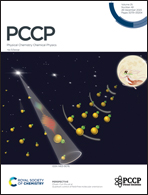A multisite dynamic synergistic oxygen evolution reaction mechanism of Fe-doped NiOOH: a first-principles study†
Abstract
Changing the composition is an important way to regulate the electrocatalytic performance of the oxygen evolution reaction (OER) for metallic compounds. Clarifying the synergistic mechanism among different compositions is a key scientific problem to be solved urgently. Here, based on first-principles calculations, a Ni–O–Fe multisite dynamic synergistic reaction mechanism (MDSM) for the OER of Fe-doped NiOOH (NiFeOOH) has been discovered. Based on the MDSM, Fe/O/Ni are triggered as the active sites in turn, resulting in an overpotential of 0.33 V. The factors affecting the deprotonation, O–O coupling, and O2 desorption during the OER process are analyzed. The electron channels related to the magnetic states among Fe–O–Ni is revealed, which results in the decoupling between OER sites and the oxidation reaction sites. O–O coupling and O2 desorption are affected by ferromagnetic coupling and the instability of the lattice O during the OER process, respectively. The results give a comprehensive understanding of the active sites in NiFeOOH and provide a new perspective on the synergistic effects among different compositions in metal compounds during the OER process.



 Please wait while we load your content...
Please wait while we load your content...